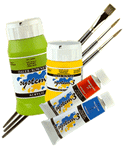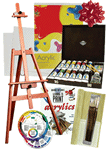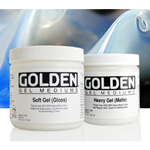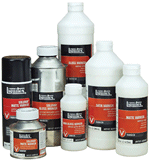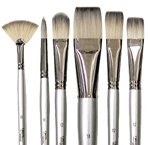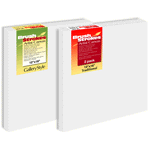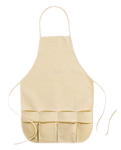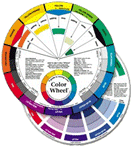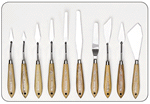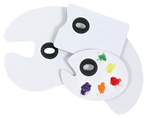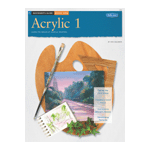ACRYLIC SHEETS
APPLICATIONS & TECHNIQUES
This process allows artists to create flexible acrylic sheets of varying size, thickness, sheen, texture and color. It can be done with a wide variety of Liquitex Mediums or combination of mediums depending upon your desired effect. Each medium chosen will impart different qualities to your final transfer.
USES
- Self Supporting Painting - Acrylic sheets can be used as self-supporting paintings (no canvas or stretcher bars). The finished painting might hang directly on wall as a quilt or unstretched canvas would.
- Collage - Acrylic sheets may be adhered to painting surface and then painted with acrylic paint or mediums.
- Sculpture - Acrylic sheets may be adhered to sculptural forms and painted with acrylic paint or mediums.
DIRECTIONS
On a smooth sheet of glass or plexiglass, tape out the desired shape and size of acrylic sheet.
APPLICATION
Brush:
- Use a ½"-2" wide, soft brush to apply desired Liquitex Acrylic Fluid Medium or acrylic medium/color mixture. For minimal brush marks, thin with 5-1 0% Liquitex Flow-Aid Water. (Flow-Aid Water is a mixture of 1 part Flow-Aid and 20 parts water).
- Allow to fully dry, depending upon environment, 1-12 hours. While wet, mediums may appear slightly cloudy. When dry, some mediums will be totally clear while others will be translucent to opaque.
- Repeat steps #1 & #2 until coating is thick enough so that you can peel it off glass without tearing; 5-12 coats will give you a thickness of 1/16"-1/8". Coat successive layers in different directions, horizontal then vertical then horizontal, etc. The thickness of the coating can vary according to your desired effect. Thin layers between 1/32" to 1/16" may be difficult to handle.
Roller
- Use a medium nap roller to apply fluid medium or paint/medium mixture. This method applies the thinnest application of acrylic. Air bubbles may dry in completed sheet.
Trowel
- Use a 2" - 6" trowel to apply a 1/8" -1/4" thick application of Liquitex Gel Medium or High Viscosity Paint/medium mixture. This method may result in an uneven application of acrylic.
Pouring
- On smooth sheet of glass, tape desired shape with masking tape in 4-5 successive layers so that a ridge or dam is built up around image.
- Use a carpenters level to insure surface is level. If surface is not level, poured fluid mediums will run toward lower edge and dry thicker at that edge.
- Pour fluid medium or paint/medium mixture over surface. Spread around with soft brush if need be while wet.
- Allow all methods to dry completely: 48-72 hours.
- Using razor blade, score along taped edges to separate sheet from tape. Peel off glass. If necessary dampen entire surface with wet sponge to release acrylic sheet from glass surface.
GENERAL ATTRIBUTES
PAINTS AND MEDIUMS
Liquitex Gloss Medium & Varnish
- When dry acrylic sheets are glossy and clear. Mix with 5-20% Medium Viscosity
Concentrated Artist Color
- Gloss colored acrylic sheet will be transparent-opaque, depending upon thickness and color.
Liquitex Matte Medium and Matte Gel Medium
- When dry, acrylic sheet is matte and opaque.
- Mix with 5-20% Medium Viscosity
Concentrated Artist Color.
- Matte colored acrylic sheet will be opaque.
Liquitex Iridescent Tinting Medium
- When dry acrylic sheet is opalescent and translucent-opaque.
- Mix with 5-20% Medium Viscosity Concentrated Artist Color. Opalescent colored acrylic sheet will be translucent-opaque, depending upon thickness.
Liquitex GlossGel Medium andGloss Heavy Gel Medium
- When dry acrylic sheet is gloss and translucent.
- Mix with 5-20% Medium Viscosity Concentrated Artist Color. Gloss colored acrylic sheet will be transparent-opaque, depending upon thickness.
Liquitex TextureGel Mediums
- Mix with 5-20% Medium Viscosity Concentrated Artist Color.
- Textured colored acrylic sheet will vary in sheen, opacity and texture.
- Mix 10-50% Texture Gel Mediums into Gloss Medium & Varnish, Gloss Gel Medium or Gloss Heavy Gel Medium. For example, Black Lava Texture Gel/Gloss Medium & Varnish mixture will result in a sheet that is transparent with black speckles.
Liquitex Interference Colors
- Mix 5-10% Liquitex Medium Viscosity Interference Color into Gloss Medium & Varnish, Gloss Gel Medium or Gloss Heavy Gel Medium.
- Interference color acrylic sheet will be opalescent.
- Mix 5-10% Liquitex Medium Viscosity Interference Color into Black Lava Texture Gel Medium.
- Resulting acrylic sheet will be dramatically iridescent metallic.
Adhering Acrylic Sheets To A Support
- Select a support that the acrylic sheet is to be adhered to: canvas, wood, Masonite TM, fabric, etc.
- Coat the backside of the acrylic sheet with either Gloss Medium & Varnish, Gloss Gel Medium or Gloss Heavy Gel Medium. Quickly position the transfer onto the support and press. To insure a uniform contact let transfer dry under weight. Cover acrylic with palette or wax paper before adding weight to prevent sticking.
- If adhering to wood or Masonite TM, the acrylic sheet may be stapled to support (in addition to or instead of gluing with mediums).


